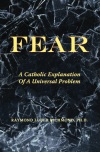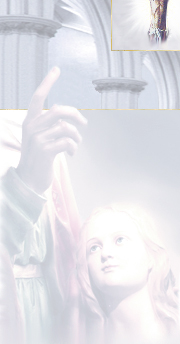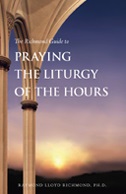|
|
|

I’m
trying to understand why it’s important to wear the veil. I came across
this and I don’t understand it.
“Any
man who prays or prophesies with his head covered dishonors his head, but
any woman who prays or prophesies with her head unveiled dishonors her
head—it is the same as if her head were shaven. For if a woman will
not veil herself, then she should cut off her hair; but if it is disgraceful
for a woman to be shorn or shaven, let her wear a veil. For a man ought not
to cover his head, since he is the image and glory of God; but woman is the
glory of man. For man was not made from woman, but woman from man. Neither
was man created for woman, but woman for man. That is why a woman ought to
have a veil on her head, because of the angels.”
—1 Corinthians 11:4–10
I kind
of resent being told I was created for man. I don’t understand why
that’s the reason to have a veil on my head. And what does it mean by
“because of the angels”?
 his passage is often misunderstood.
Not only will you find that many women today who wear a chapel veil at Mass
cannot explain the real reason for covering their heads, but also you will
find contemporary Biblical commentators trying to “explain away”
this passage by saying that it refers to an ancient social custom that no
longer has any relevance to today’s world; then they will say that they
don’t have a clue as to what Saint Paul meant about “the
angels”. his passage is often misunderstood.
Not only will you find that many women today who wear a chapel veil at Mass
cannot explain the real reason for covering their heads, but also you will
find contemporary Biblical commentators trying to “explain away”
this passage by saying that it refers to an ancient social custom that no
longer has any relevance to today’s world; then they will say that they
don’t have a clue as to what Saint Paul meant about “the
angels”.
The truth is, Saint Paul was
emphasizing a mystical principle here that is just as relevant today as it
was in his own time; moreover, being mystical, not secular, this principle
has no sexist implications.
To understand the passage, we
need to distinguish two separate concepts: (a) social dignity, and (b) lust
as one form of demonic influence.
Social
Dignity
In the ancient world, even the
pagans recognized the value of human dignity and used clothing to protect
that dignity. Slaves may have gone around nearly naked, but respectable citizens
wore fine clothes to mark their social status. Moreover, slaves may have had their
heads shorn to facilitate their menial labors—or to strip them of their
individuality and dignity—but respectable women kept their hair long
as a statement that they had the freedom and the means to care for their beauty.
Respectable women also kept their heads covered as a form of natural and
social protection.
Notice carefully:
protection, not mere custom.
For both men and women, head
coverings protected the hair and face from natural elements such as sun,
wind, and dust. Furthermore, head coverings protected women in particular
from the social danger of men’s lust.
Note that, in a paradoxical twist
of psychology, an ordinary veil tends to cover something only to incite the
viewer to wonder what is behind the veil. When a veil is used as a head
covering, however, it serves a function different from an ordinary veil. Rather
than hide a woman’s head from view, the veil makes a psychological and
spiritual statement about the woman’s dignity and thereby protects her
from any lustful gaze.
Keep in mind here that all humans
have a basic human dignity as individuals created by God, but that men and
women also have a particular dignity deriving from their gender. Men have
the dignity of being fathers, and women have the dignity of being
mothers.
|
For the Jews,
these gender roles derived from God Himself, and the male-female bond in
marriage symbolized God’s personal care for humanity. Christianity
heightened the meaning of this bond, pointing to its penitential, prayerful,
and sacrificial nature of personal renunciation for the sake of the Kingdom
of God. |
|
Consequently, a woman—whether
pagan, Jew, or Christian—of Saint Paul’s time protected her social,
feminine dignity by shielding her head from the gaze of men, to signify that
she was, or intended to be, a
mother,[1]
and that she was not a slave to lust.
Saint Paul referred to this concept
of social dignity when he said that a woman, like a slave, loses her dignity
when her hair is shorn, but the point he makes about a woman covering her head
during prayer takes us a step beyond the social level into the mystical realm
of demonic influence.
Demonic
Influence
Chapter 6 of the Book of Genesis
tells the story of the origin of the Nephilim. Biblical commentators tend
to dismiss this account as something borrowed from ancient mythology and
therefore of no real theological value. Sadly, they miss an important point.
Nevertheless, Anne Catherine Emmerich,
in her mystical visions of ancient Biblical history, brings us right to the point
of the story of the Nephilim.
|
 I saw Cain’s descendants becoming more and
more godless and sensual. They settled further and further up that mountain
ridge where were the fallen spirits. Those spirits took possession of many
of the women, ruled them completely, and taught them all sorts of seductive
arts. Their children were very large. They possessed a quickness, an aptitude
for everything, and they gave themselves up entirely to the wicked spirits
as their instruments. And so arose on this mountain, and spread far around,
a wicked race which by violence and seduction sought to entangle Seth’s
posterity likewise in their own corrupt ways. Then God declared to Noe His
intention to send the Deluge. I saw Cain’s descendants becoming more and
more godless and sensual. They settled further and further up that mountain
ridge where were the fallen spirits. Those spirits took possession of many
of the women, ruled them completely, and taught them all sorts of seductive
arts. Their children were very large. They possessed a quickness, an aptitude
for everything, and they gave themselves up entirely to the wicked spirits
as their instruments. And so arose on this mountain, and spread far around,
a wicked race which by violence and seduction sought to entangle Seth’s
posterity likewise in their own corrupt ways. Then God declared to Noe His
intention to send the Deluge. |
|
| |
—The Life of Jesus Christ
Vol. 1, Sin and Its Consequences, Ch. 5
as told by the Venerable Anne Catherine Emmerich |
|
The point of this story is not just that
wicked spirits—that is, fallen angels, or demons—can exert a powerfully
negative spiritual influence over us, but that one primary pathway of this demonic
influence is seductiveness and lust.
|
We know that lust is
a sin because it is one of the seven deadly
sins [2].
Lust is a sin precisely because it makes a person into an object; that is, it sees
another person in terms of whatever pleasure that person can bring to you. Whereas
love wishes good to
someone,[3]
lust seeks your good at the use of someone. You can use a person in actuality or in
your imagination, but, either way, lust, being the opposite of love, is an act of
hatred. |
|
And the underlying motive for this seductiveness
and lust is social acceptance.
Social Acceptance
Children, as infants, need acceptance from
their parents in order to receive from them the resources necessary for their survival.
Moreover, throughout childhood the children continue to need parental acceptance and guidance
so that they can grow and acquire the skills necessary to function successfully in the world.
Furthermore, as they progress through childhood and adulthood, men and women, because of
their natural God-given differences, develop different strategies to gain acceptance from the
world to aid their social functioning.
Traditionally, men get acceptance through
their minds, using mental strategy for mastery in business and science. They also get
acceptance through their bodies, using physical strength for mastery in such things as
athletics and combat.
Traditionally, women get acceptance through
their minds, using intuitive understanding for success in such things as raising children,
teaching, and health care. They also get acceptance through their bodies, using sexual
allure to attain mastery in social status.
Notice, however, that none of these paths
to social acceptance can impress God. Military power and athletic prowess mean nothing to
almighty God, and business and science are trifles to the all-knowing God. Similarly,
intuitive understanding fills the spiritual realm, while sexuality has no place in the
spiritual realm, and so these things, too, cannot impress God.
In fact, nothing we do can impress God. Nor
do we have to impress God; God accepts us purely out of His love. All we need to do to
receive God’s love is not push it away by committing sin. Therefore, if men and women take
pride in making themselves socially accepted, they push God’s love away because pride is a
sin—like lust, one of the seven deadly sins. Furthermore, being a sin, pride is an act of
insult to and hatred for the divine.
|
This is why military uniforms,
athletic insignia, and showy jewelry cause scandal during divine liturgy. All these things
are acts of pride which, in general, put self-interests before God and therefore push away
God’s love. But to bring this pride into a divine liturgy amounts to throwing an insult
right into God’s face. |
|
To the demons, our pride is their delight,
because our pride is an opening for the demons to exert their evil influence. And
when women use the pride of sexual allure to gain social acceptance, the demons are drawn
to it like sharks are drawn to blood in the water.
Consequently, both men and women need to
present themselves before God—and to protect themselves from demons—with reverent
humility and with reverent modesty.
Moreover, in church especially, where we open our hearts in deep vulnerability to Christ,
women need to protect themselves from demons by covering their heads, the apex of their
physical beauty, with a holy veil, to renounce the desire to use feminine beauty
to make themselves be accepted by others. Otherwise, the pernicious and desperate desire to
be accepted by others will become a pathway for demons to “accept” them and
enter their vulnerable hearts.
|
Note that a woman’s
beauty per se is not a spiritual danger. Demons do not feed on innocent
beauty; they feed on the corruption in a woman’s heart that results from
her using her sexual allure to attract others and be accepted by them. |
|
Angels and Fallen
Angels
The Church has always known that angels
exist. The Bible recounts many stories about the archangels Michael, Gabriel, and
Raphael. Moreover, even today in the Angelus we recall
how an angel announced the Incarnation to the Blessed Virgin, and even today, at
Mass, we affirm that angels carry our sacrifice to heaven. We also know that demons
exist because Christ cast out demons as a regular and on-going aspect of His healing
ministry.
|
Many persons today—even
many priests—propagate the false idea that when Jesus cast out demons He was really
curing a mental illness. But the truth is, Jesus well knew the difference between a
demon and a psychological or medical problem. How could the Lord Himself not know
His own creation? |
|
Saint Paul, too, knew that
fallen angels exist, and he knew of their demonic influence.
He knew that fallen angels can take possession of women, rule them completely, and teach
them all sorts of seductive arts. That’s why he warned women to cover their heads when
they pray. He knew that if a woman in prayer covers her head, she protects herself from
the gaze of the fallen angels and thereby denies them the opportunity to feed upon
feminine immodesty and pride. Therefore, when a woman covers her head in prayer she takes
a noble stand in the great spiritual battle against
evil.
|
The entire Church
Militant is faced with this spiritual battle—but it cannot be fought just with
a manual of prayers to recite with your lips. Christ Himself taught us that the
real weapon against evil must come from deep within the heart: for the love of
God, renounce your desire to
sin.[4]. |
|
The Example of Mary
Consider the following passage from the
Venerable Anne Catherine Emmerich who, in the course of her extensive spiritual
visions, witnessed the actions of the Blessed Virgin just before the
Annunciation.
|
Anne seemed to be
very busy about the household affairs, and for a time she moved about here and
there, while the Blessed Virgin ascended the steps to her room. There she put
on a long, white, woolen garment, such as it was customary to wear during prayer,
a girdle around her waist, and a yellowish-white veil over her head. The maid
entered, lighted a branched lamp, and retired. Mary drew out a little, low table,
which stood folded by the wall, and placed it in the center of the
room. . . . When the little table was prepared, Mary laid a small,
round cushion before it and, resting both hands on the leaf, she gently sank on
her knees, her back turned to her couch, the door of the chamber to her right.
Mary lowered her veil over her face, and folded her hands, but not the fingers,
upon her breast. I saw her praying for a long time
with intense fervor. . . . |
|
| |
—The Life of Jesus Christ
Vol. 1, The Most Holy Incarnation, Ch. 3 (The Annunciation)
as told by the Venerable Anne Catherine Emmerich |
|
Now, if Mary wore a veil simply
for social reasons, then why would she bother to put on a veil to pray when
she was alone and hidden from human eyes? Well, she wore the veil for spiritual
reasons, not for human reasons, and every woman today would do well to take her
as an example.
Woman is the
Glory of Man
Still, many persons today say, “This
is all ridiculous. Let’s bring Christianity into the modern
world!”
Well, in order to further its anti-Christian
progressive liberal agenda, our culture of insanity has been working for decades to
undermine reverence for God by defiling the natural, God-created differences between
men and women. Today we are all being taunted by demonic influence to blur gender
differences,[5]
and even Christians are becoming blind to the pernicious cultural insanity
surrounding them and slowly infiltrating the Church and the core of faith
itself.
Jacques Lacan, in his writing (see
the book Feminine Sexuality: Jacques Lacan and the école freudienne and
the chapters “God and the Jouissance of The Woman” and “A Love Letter”) speaks of
the psychoanalytic concept of “lack.” Although he uses some complicated mathematical
imagery and abstruse psychoanalytic language to describe the matter, this concept of
“lack” could be summed up theologically by saying that we cope psychologically with
our human brokenness—that is, our separation from God—by using
illusions to create
for ourselves experiences of comfort in the midst of our misery. The illusions are
varied, such as food, drugs, romance fantasies, sexual activity, sports, militarism,
and politics, and the comfort can take the form of pleasure, pain relief, social
acceptance, and personal valuation.
Lacan points out that one “side” of life
is characterized by the use of this dynamic of illusions/comfort as an unconscious
compensation for our brokenness. Moreover, Lacan demonstrates that there is another
“side” of life that isn’t trapped in lack but that experiences something very real,
albeit “unknown.” Lacan speaks of this experience as something that many women
have encountered; it’s an ecstasy they experience without knowing what it is, and so
Lacan refers to it as something “beyond sex” and thus as something mystical.
Furthermore, Lacan states that even though most men are trapped on the “lack” side of
life, some of them also encounter the mystical experience.
Note carefully that Lacan spoke as a
psychoanalyst who was concerned with issues of neuroticism and sexuality, and so he
didn’t elaborate on his ideas as theological concepts. Nevertheless, to speak theologically,
it can be said that the side of life not trapped in lack is the place of mystical religious
experience, and that it is characterized not by futile efforts of compensation for what
is lacking but by a real experience of a fulfillment of a yearning for God.
Hence we can define mystical ecstasy
as a prescient experience of a complete union with God.
Because the mystical experience is beyond
sex, both men and women can be mystics; nevertheless, more women than men tend to have
mystical experiences. This can be explained by the fact that anyone who preoccupies
himself or herself with illusions of compensation is obstructing the mystical experience.
In the past this was true of most men, and it is still true of most men today. And, in
the past, many women were not drawn to these illusions. But today, sadly, because of
feminixt efforts in regard to “women’s liberation,” more and more
women are being “liberated” into sin and are crossing over into the use of illusions
typically used by men.
Still, women who value the
supernatural—rather than shake it off as a burden—can have a special role
in their spiritual influence on men. In the book of Genesis we are told that the desires
of man’s heart are evil from his youth (see Genesis 8:21). In other words, both men and
women are prone to all illusions as a fact of (fallen) life, just as much today, in the
modern world, as in the past. Women, however, can be the glory of man (see 1 Corinthians
11:7). “Woman is the glory of man” means that when women seek the mystic way of life—that
is, a way of life governed not by an attempt to compensate for lack and limitation but by
a profound embrace of the fullness of God’s love—they renounce illusions for the sake of
an experience that is beyond sex, and so they take up a God-given spiritual authority
to relate to men with a real love that puts men in their proper spiritual place of loving
God rather than loving illusions.
Consequently, by wearing a veil a woman is
declaring that she renounces the love of illusions because of her love for God. But,
although the veil is worn over her head, a woman must pray for it to cover her heart,
as the fulfillment of her renunciation of illusions about sexuality; thus her veil will
be real protection, not just a rote obligation.
So let’s consider how a veil can be worn
properly.
To Wear a Veil Properly
The 1917 Code of Canon Law (Can. 1262 §2)
says that women are required to cover their heads in church; today, liberals and feminists
say that the 1983 Code of Canon Law abrogated the rule of head coverings. But traditionalists
say that because the 1983 Code of Canon Law makes no mention of head coverings and does not
specifically change the old law, then, pointing to Cann. 20, 21, and 28 of the 1983
Code,[6]
they say that Can. 1262 §2 of the 1917 Code has not been abrogated and is still in
effect today.
But we really do not have to be obsessed with
these legal arguments. A chapel veil should not be worn to fulfill a law or to
avoid fear of mortal sin; a chapel veil should be worn as protection from
the spirit of lust and as protection from demons who feed on lust.
To wear a veil properly, then, wear it for
the love of God, not for the sake of
duty.[7]
Wear it for protection from all that is impure. But let the veil be a proper veil, such
as an elegant scarf or shawl covering your shoulders and head, rather than a flimsy piece
of lace precariously balanced on the top of your head. Similarly, a cropped lace “veil”
that exposes the back of your head fails in the true function of a veil of protection. For
the same reason, a hat also is not liturgically appropriate. Furthermore, a hat can just as
well be worn socially to increase a woman’s attractiveness, so wearing a hat in church has
no protective purpose for a woman.
|
Because hats are socially
acceptable for women in all circumstances, a woman of lukewarm faith might wear a hat
in church to fulfill the “duty” of covering her head while comfortably knowing that
she will not lose the acceptance—and suffer the scorn—of oppositional
women [8]
who refuse to wear a veil. |
|

|

|

|
A chopped veil that
falls short as a proper veil. |
A good lace veil that
covers the back of her head and neck. |
An elegant use of a scarf
as a chapel veil that covers the neck. |
Put on the veil before entering the
church and don’t remove it until you have left the church. Why? Well, remember
that Christ is physically present in every Catholic and Orthodox church, and to encounter
Him with chaste respect a woman veils her head before stepping into His presence. The
veil brings protection and honor to any woman’s deep, prayerful encounter with the
holy; the veil is not just a “duty” of the Mass itself.
Consequently, it is also most beneficial for
a woman to wear a veil even when praying outside a church, whether in public (such as in
a prayer group, in a Eucharistic Procession, or outside an abortion facility) or privately
in her own home (as did the Blessed Virgin herself).
|
Regarding private prayer,
it might be asked, “If a woman, like all Christians, should be praying constantly,
then shouldn’t she be wearing a veil constantly?” Well, no. The veil is protection for
those times when a woman is focused totally on prayer and is therefore most spiritually
vulnerable. Accordingly, if a woman is doing other activities, such as household tasks,
while she is praying, then she isn’t totally vulnerable and so a veil is not
necessary. |
|
The “Veil” of Modest Clothing
Although the veil serves as protection for a
woman during prayer, for a woman to protect her dignity at all times, let her ensure that
all of her clothing is elegant, modest, and reverent.
Body Contours
If a woman desires to be
modest and reverent, she will protect the contours of her body
by not wearing any tight clothing. This is especially true in regard to avoiding leggings,
jeans, and slacks; hence, for the sake of modesty and reverence, a woman will wear a long
(below the knees) loose skirt to protect her lower body.
|
When a woman wears pants,
she emulates men in their clothing. To emulate is to imitate with the
intention of competing with, surpassing, and triumphing over someone. Emulation,
however, is a sin, as Saint Paul said (see Galatians 5:19–21). Feminixts,
though, gloat in emulating men because of their hatred for men and
authority. |
|
Note that a woman who wears leggings, jeans, or slacks
(instead of a loose skirt) while wearing a veil resembles an ostrich with its head
buried in the sand while its butt is pathetically
exposed [9]
for all to see.

|
An ostrich veil. |
Bare Skin
Furthermore, if a woman desires to be
modest and reverent, she will not only protect her bare skin
by covering her shoulders, but she will also avoid V necklines and low necklines, which point
attention down to her breasts.
Sex Toys
Hence, regardless of how they perceive
themselves in their own minds, and regardless of what “everyone else” does, women
who forsake modesty and reverence have forsaken their supernatural feminine glory,
and so they make themselves into sex toys in the eyes of men.
Summary
Think of what occurred in the
mid-20th century: liturgical ceremony declined;
reverence for the Blessed Sacrament declined; devotion to Our Lady and the Rosary
declined; the beauty of Gregorian chant was neglected; women stopped covering
their heads when they prayed—and demons frolicked in the Church.
When stripped of its divine dignity,
Christianity is reduced to the intellectual nakedness of humanistic
sentimentality. In that forlorn place, truth becomes nothing more than
diversity. “What’s impurity?” we say. “God is love. God
created everything. Everything is good and pure.” With purity diluted to the
point of irrelevance, belief collapses. And where, then, does that leave faith?
That’s what Jesus asked. “But when the Son of Man comes, will He find faith on
earth?” (see Luke 18:8).
So where is our help now? Well,
if women revere chastity, dress
modestly at all times, and act with
humility in all things, they will be
a holy influence on men and society, and if they cover their heads when praying
they will protect themselves spiritually from the gaze of demons who feed upon
pride, irreverence, and impurity.
Women have a crucial mission—a
supernatural mission of purity—in liberating themselves, the Church, and society
in general from the oppression of pride, irreverence, and impurity that, day by
day, are increasingly attacking us all.
Our help is in the name of the
LORD, Who made heaven and earth—and Who made woman as
the glory of man, to honor her and protect man from himself.

Notes.
1. Nevertheless, some women may willingly renounce
marriage and motherhood for the sake of the Kingdom of Heaven.
Infertility, however, is another matter.
2. The seven deadly sins are pride, avarice, envy,
wrath, gluttony, sloth, and lust.
3. To love is to wish the good of another. See Thomas
Aquinas, Summa Theologica I–II, 26, 4. Saint Thomas acknowledged that this
definition of love came from the writings of the ancient Greek philosopher Aristotle.
(See Aristotle, Rhetoric ii, 4).
4. Consider that Dante’s Divine Comedy
begins with Dante lost in a dark woods; he tries to escape by climbing over a beautiful
mountain but is driven back by three fierce animals, a leopard (symbolizing lust), a lion
(symbolizing violence) and a wolf (symbolizing malice). He then has to face his inability
to guide himself and, renouncing his cowardice, agrees to follow Virgil down into
hell as the path to Purgatory. Allegorically, this means that
in order to attain holiness we must all descend into the inner hell of a “will to sin” that
lurks in the unconscious of
us all and that will lead us to our doom unless we encounter it
and pass beyond it with a courageous desire for purification.
For more information about the psychological aspects of this healing process, see my
book Healing.
5. For example, the feminist ideal
for women today is to forsake feminine modesty, throw off the yoke of the “supernatural,”
and adorn themselves with lust and anger. To get on the fast track of social success, women
are pushed into competing with men by dressing in the same uniforms as men, to compete with
other women as sex objects, and to compete with both men and women in business by acting
like hostile, cold-hearted men.
6. Can. 20: “A later law abrogates or derogates from an
earlier law, if it expressly so states, or if it is directly contrary to that law, or if
it integrally reorders the whole subject matter of the earlier law. A universal law,
however, does not derogate from a particular or from a special law, unless the law
expressly provides otherwise.”
Can. 21: “In doubt, the revocation of a previous law is not presumed;
rather, later laws are to be related to earlier ones and, as far as possible, harmonised
with them.”
Can. 28: “Without prejudice to the provisions of can. 5, a custom,
whether contrary to or apart from the law, is revoked by a contrary custom or law. But
unless the law makes express mention of them, it does not revoke centennial or immemorial
customs, nor does a universal law revoke particular customs.”
7. In its psychological sense, duty has
nothing to do with love. When you act out of duty you are trying either to
gain someone’s approval or to avoid losing someone’s approval. Love, in contrast,
has no ulterior goal; the purpose of love is love. Love is its own reward.
Nevertheless, it is possible to speak of one’s “duty” to love
and worship God, but when used in this unique theological sense the word duty
simply points us to a need to avoid being careless about, or ungrateful for, the
ineffable love which God bestows upon us.
8. Such as women fallen under the influence of
feminixm. And feminixm, in turn, is an ideology fallen under
demonic influence. So a woman who refuses to wear a chapel veil is really wearing a
Satanic “veil”: the occult veil of demonic influence.
9. It’s also pathetic for a woman because if the
demons cannot make a frontal attack because of her veil they will come up from the rear
(literally) to attack where her defenses are weak.


Healing
|
Though
Demons
Gloat
|
Anger
&
Forgiveness
|
Falling
Families,
Fallen Children
|
Disasters
and
trauma
|
Psychology
from the
Heart
|
 |
 |
 |
 |
 |
 |
Psychological Healing
in the Catholic Mystic tradition |
True Christian
Identity
In Confronting
Evil |
How to Turn the
Emotional Wounds
of Daily Life Into
Psychological Growth. |
The Psychological
and
Spiritual Remedy
For Our Cultural
Disintegration |
The Struggle For
Psychological
and Spiritual
Growth |
Collected Texts
About the Spiritual Depth of
Clinical Psychology |
More information |
More information |
More information |
More information |
More information |
More information |
Desire
and
Distraction
|
Fear
|
Stopping
Smoking
|
Borderline
Personality
Disorder
|
Catholic
Compassion
|
 |
 |
 |
 |
 |
A Catholic Perspective
On Behavioral Change
and Its Subversion |
A Catholic Explanation
Of a Universal
Problem |
Through
Faith
and
Prayer |
Healing
the
Rage |
When They Tell You
That the Moral Teachings
of the Catholic Church
Are Wrong |
More information |
More information |
More information |
More information |
More information |
|

























